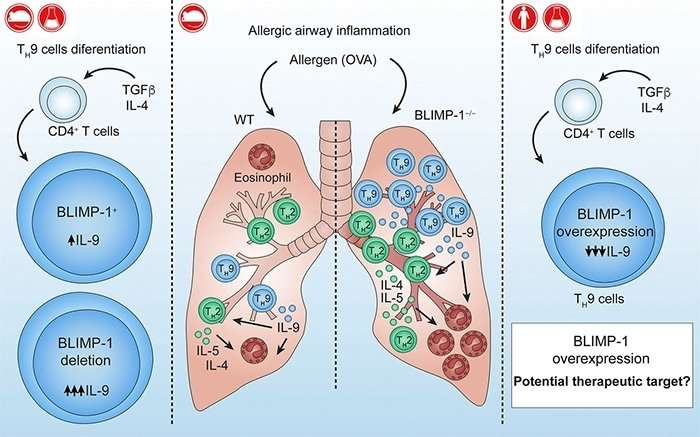Pathway to resolve allergic asthma is discovered

A group of Brazilian researchers succeeded in preventing allergic asthma from progressing in experimental models by increasing the amount of a certain protein. This increase, in turn, blocked the CD4+ T lymphocytes responsible for producing a cytokine that triggers a cascade of events resulting in the onset and progression of the disease.
The knowledge of how the disease can be resolved in cell cultures and animals will form a basis for the research and development of a drug to control expression of this protein in experimental models and humans. The study was conducted by members of the Center for Research on Inflammatory Diseases (CRID). The results were published in the Journal of Allergy and Clinical Immunology.
"People with allergic or bronchial asthma are currently prescribed drugs such as antihistamines, bronchodilators and corticosteroids, which inhibit the symptoms of the disease, but also inhibit the cellular response, including that of TH2 lymphocytes," said João Santana da Silva, a professor at FMRP and principal investigator for the project.
"TH2 lymphocytes lead to the production of substances that cause the symptoms, so this treatment strategy targets only symptoms such as rhinorrhea [runny nose], breathlessness and so on. What we discovered is that if other T lymphocytes called TH9 cells are blocked, the disease will be effectively resolved and the production of substances that cause the symptoms will stop," Silva said.
To achieve these results, the researchers performed experiments with cell cultures from mice and humans as well as transgenic mice.
The experiments confirmed that when the gene Blimp-1 is overexpressed, production of the protein it encodes, which is also called Blimp-1, increases, and this protein blocks the action of the lymphocytes that produce IL-9, a cytokine that causes allergic airway inflammation. "The key point is that blocking IL-9 weakens the response by TH2 cells, slowing progression of the disease," Benevides.
Blimp-1 gene
To test the hypothesis that Blimp-1 plays an important role in allergy resolution, the researchers created transgenic mice with this gene switched off in their T lymphocytes. Because the gene has other functions, it could not be completely silenced, so they used a technique called conditional knockout, so the gene would fail to function only in T-cells.
Next, both transgenic mice with Blimp-1 deleted in their T-cells and control mice were submitted to a procedure that induced an allergy. The researchers injected doses of ovalbumin and then introduced the same substance into the animals' nostrils (intranasal instillation), producing airway inflammatory disease as a result of an allergy to egg white protein.
When they analyzed the reactions in the two groups of animals, they found that the mice without Blimp-1 suffered the effects of allergy much more than the mice that had the active gene.
"Although both groups developed the allergy, we showed that the animals without Blimp-1 in their T-cells had far more intense lung inflammation than the control animals," Benevides said.
Having demonstrated the role of Blimp-1 in inflammation, the researchers created a method for overexpressing the gene to see whether the abnormally large amount of protein produced would inhibit production of the cytokine IL-9.
They then collected samples of human peripheral blood mononuclear cells, which are widely used in immunology research. Samples were collected from healthy individuals and people with allergic asthma.
The blood cells received an innocuous virus or a virus that contained Blimp-1, which became part of the cells' DNA. In cells from both healthy and asthmatic individuals, Blimp-1 produced large amounts of protein and inhibited the production of TH9, which produces IL-9.
Although IL-9 was expressed in the cells from both healthy and asthmatic individuals, its expression was more intense in the latter. The same result was observed in a similar experiment with murine cells.
Use in other diseases
Based on these findings, the group now plans to develop drugs capable of inducing Blimp-1 expression to control TH9 cells. "We're testing its role in the regulation of TH9 cells using other experimental models, such as tumors, but it's too soon to draw any conclusions," Benevides said.
In the case of cancers such as melanoma, preliminary experiments that have not yet been published show that when Blimp-1 expression is reduced, the resulting increase in TH9 cells leads to a reduction in tumor size.
A cancer drug developed on this basis would therefore inhibit Blimp-1 expression, whereas a drug for asthma and autoimmune diseases would boost Blimp-1 expression.
"The most important discovery is a new function for a well-known transcription factor, which we now know to also be capable of inhibiting the differentiation of IL-9-producing T-cells. This opens up the prospect of research on several diseases in which TH9 cells are involved," Benevides said.
More information: Luciana Benevides et al, B lymphocyte–induced maturation protein 1 controls TH9 cell development, IL-9 production, and allergic inflammation, Journal of Allergy and Clinical Immunology (2018). DOI: 10.1016/j.jaci.2018.06.046


















